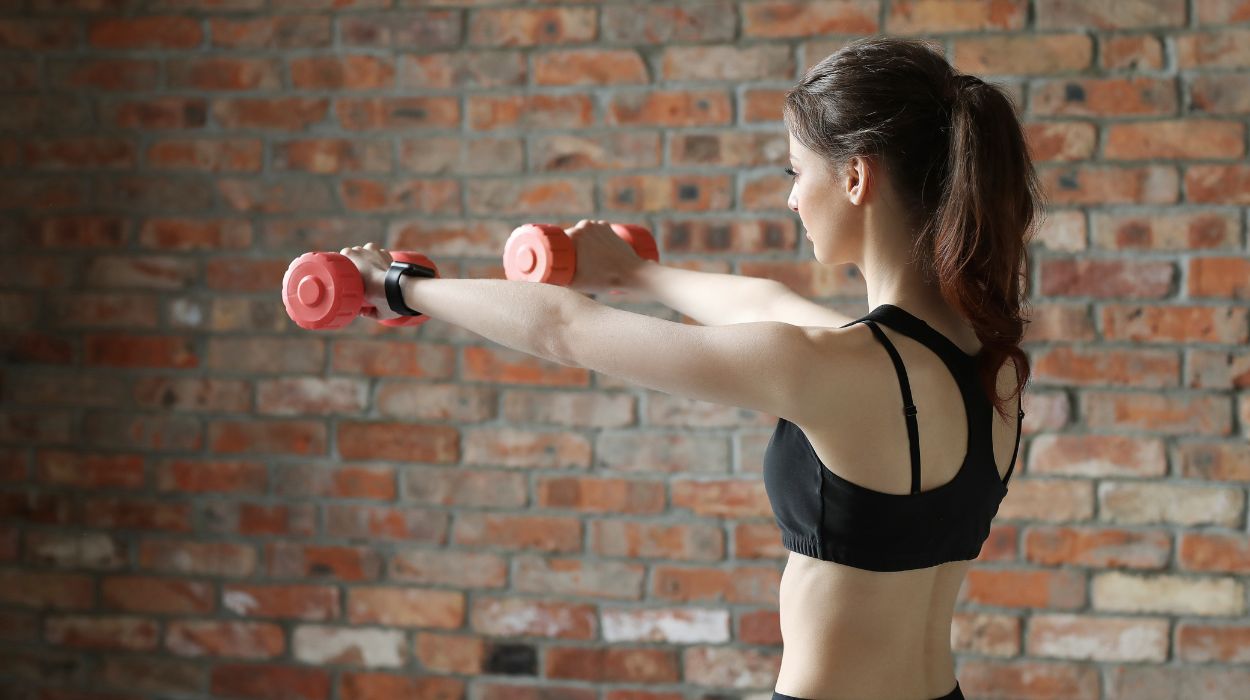
The internet can be a highly resourceful place to seek arm and shoulder workout routines.
However, the issue with a broad search is that you are often presented with too many options.
Fitness professionals may base shoulder exercises for women into a few categories: the targeted muscle group, the movement pattern, and the equipment you use.
Shoulder exercises target the anterior, lateral, and posterior deltoid muscles. Anterior deltoids are shoulder muscles at the front, and lateral muscles are on the side. The rear or posterior deltoids are at the back.
You can exercise the shoulders using bodyweight movements or implement various pieces of equipment, such as bands, medicine balls, dumbbells, and cables.
Here we’ll expound on all the types of shoulder workouts for women. Keep reading if your goal is to improve posture, gain upper body strength, or mobility. We’ll list the exercise in its best stance and name any necessary equipment.
Best Shoulder Workouts For Women To Sculpt Arms
Five Shoulder Exercises For Women In 2024
Women, like men, need effective shoulder exercises for many reasons. Strong shoulders improve posture, prevent slouching, and may ease neck and back strain.
Upper body workout women also improve the strength needed in their roles at work and home. Shoulder workouts in women’s routines also help reduce injury by improving shoulder and arm mobility and flexibility. They also prevent rotator cuff tears and shoulder joint dislocations.
These movements also boost your athletic performance, especially for hand-held sports and games. In basketball and swimming, female athletes rely on their shoulders to perform at their best.
Shoulder exercises also support healthy bone density. Low bone density may lead to osteoporosis, a medical condition characterized by weak and brittle bones.
Women are more prone to develop osteoporosis[1] than men because men typically have higher bone density. Women also lose bone mass faster, with about 25% of postmenopausal women[2] classified as fast bone losers.
For these reasons, consider adding the following shoulder exercises for women to your workout routine.
Overhead Barbell Press
The dynamic Overhead Barbell Shoulder Press targets the anterior deltoid muscles in your upper arms. This compound movement also engages the lateral deltoids, upper chest, trapezii, and core. While the overhead shoulder press is often done using a barbell,[3] it can also be done with dumbbells and various machines.
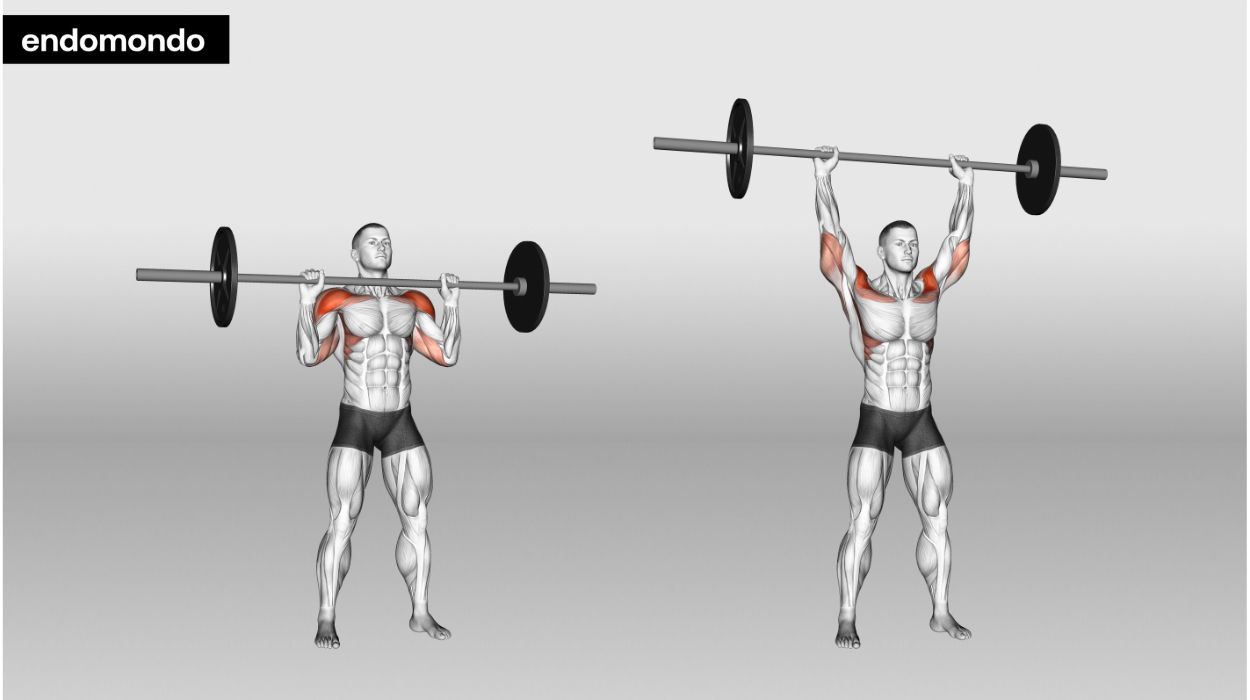
How to do:
- Stand with your feet shoulder-width apart.
- Grasp the barbell with an overhand grip, hands slightly wider than shoulder-width.
- Bring the barbell up towards your chin, bending at the elbows and turning your palms to face away from you.
- Lift the barbell overhead, extending your arms fully.
- Slowly lower the barbell to back-to-shoulder height, maintaining control.
- Repeat for the desired reps.
Tips:
To gain the most from your Overhead Shoulder Press:
- Keep knees slightly bent for stability.
- Engage your core throughout the exercise.
- Maintain a straight line from your shoulders to your feet.
- Avoid locking your elbows at the top.
- Ensure a controlled descent preventing shoulders from popping.
Optimal Sets & Reps: 3 sets of 8-10 reps.
Lateral And Frontal Raises
Shoulder raises are another compound exercise encompassing two actions: external rotation and abduction.
External rotation is when the upper arm bone rotates outwards from the body. During this movement, your thumb rotates upwards as you raise your arm. Abduction is moving your arm away from the body in a horizontal plane. You move the arm until it is parallel to the floor.
These work the deltoid muscles, but they also target different muscles based on the direction you lift your arms. Frontal raises target the front shoulder muscles, while lateral raises target the side shoulder muscles. You can use dumbbells or the cable machine to complete these exercises in a seated or standing position.
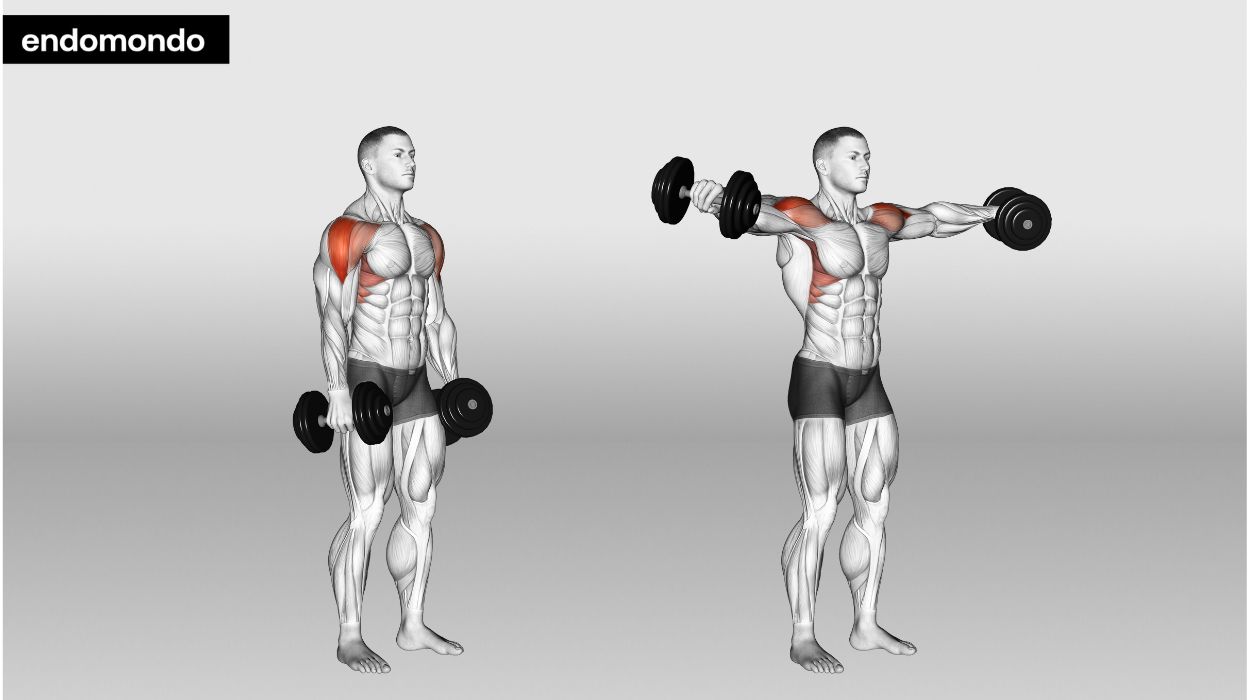
How to do:
- Stand with your feet hip-width apart, dumbbells in hand, and arms straight.
- Lift both arms laterally, palms facing down, to shoulder level.
- Maintain a slight bend in the elbows for optimal engagement.
- Slowly lower the dumbbells back to the starting position.
- Perform the exercise for the recommended reps, ensuring a controlled motion.
Tips:
To get the best out of any right or left arm raises,
- Keep your core muscles engaged to stabilize the body.
- Avoid locking elbows and overextending the arms.
- Keep movements controlled to prevent shoulder strain.
- Incorporate a few inches of movement for added intensity.
- Ensure both shoulders are worked equally for symmetry.
Optimal Sets & Reps: 3 sets of 12-15 reps.
Face Pull
The Face Pull targets the posterior deltoids and rotator cuff muscles. You can perform them using cables or resistance bands, pulling the equipment of choice toward your face. This motion engages the shoulder blades and upper back muscles.
Face Pull variations can vary based on:
- Equipment: cable machine or elastic band.
- Grip Type: Neutral with the palms facing downwards, targeting the posterior and rotator cuff, or supinated with palms facing each other, targeting the rhomboids and trapezius.
- Body Stance: kneeling, standing, or seated.
- Pull Direction: towards the middle of the face or toward the forehead.
Studies support that this shoulder exercise using elastic bands may correct a rounded back.[4]
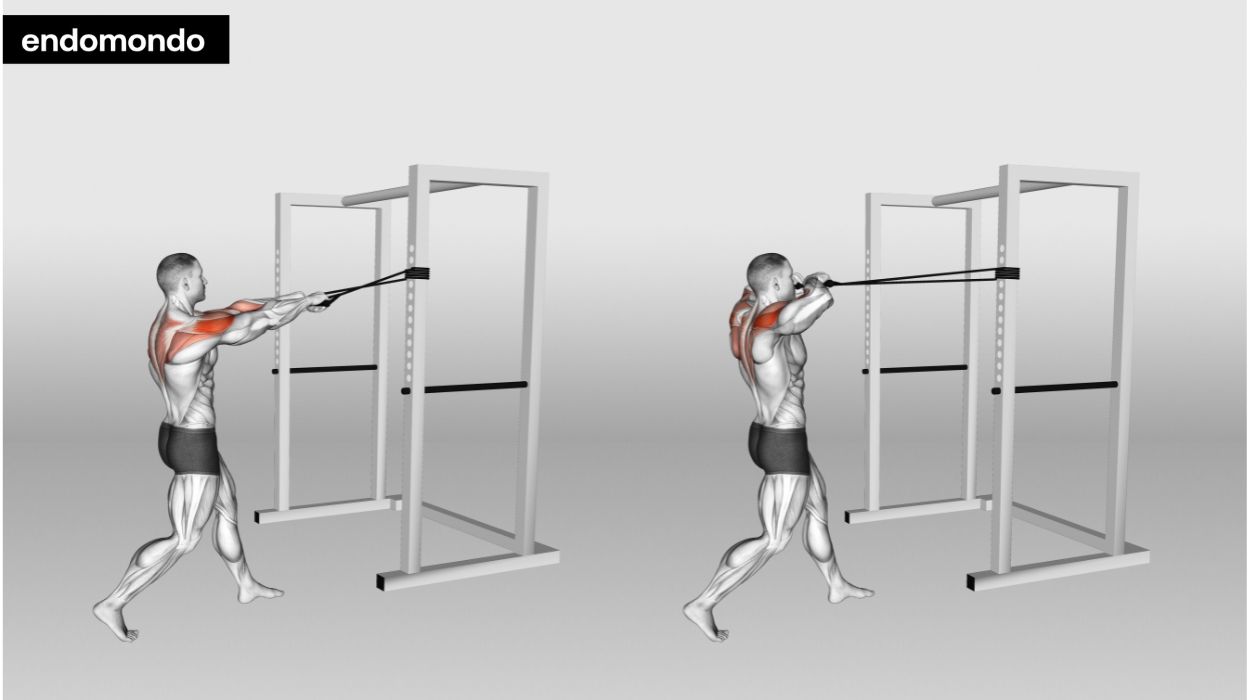
How to do:
- Loop the elastic band around an anchor point and align it to your height. This is the starting position.
- Grasp the band, palms facing downwards.
- Step back and stand upright.
- Pull the band towards your face, keeping elbows high and aligned with your shoulders.
- At the peak, squeeze your shoulder blades together.
- Slowly release the tension and return to the starting position.
- Perform your intended reps, ensuring controlled movements.
Tips:
To ensure you gain the most from this movement in your cable shoulder workouts, adhere to the following:
- Keep your legs apart with a slight bend in the knees.
- Engage your core.
- Focus on the muscles between the shoulder blades during the squeeze.
- Control the speed to avoid jerky movements.
- Maintain a neutral spine throughout the exercise.
- Adjust the weight to ensure proper form.
Optimal Sets & Reps: 3 sets of 12-15 reps.
Reverse Fly
This movement is called the Rear Delt Raise or Bent-Over Dumbbell Reverse Fly. Reverse flies are weight-training exercises that strengthen the posterior deltoids. They also engage the back and core muscles.
Variations of the reverse fly are based on:
- Equipment: dumbbell, cables, or machine.
- Body Position: standing, leaning, seated, or kneeling.
- Movement: Directions and surface inclination.
In a 2017 study, EMG tested the dumbbell reverse fly on varied surfaces. It revealed that higher inclines maximally activate anterior deltoids.[5] Unstable surfaces showed similar muscle activity with reduced weight. EMG measured muscle electrical activity, offering a comprehensive analysis of muscle engagement in diverse conditions.
This movement could be a suitable fit for rehabilitation programs.
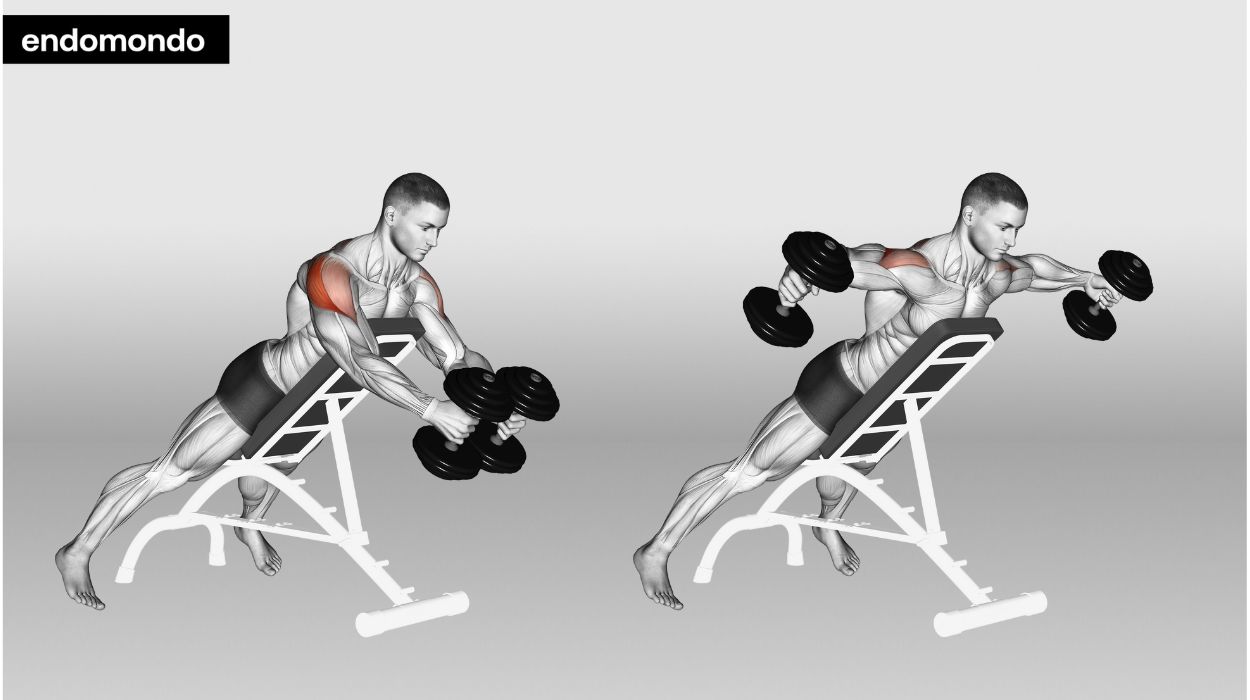
How to do:
- Stand with feet shoulder-width apart, holding a dumbbell in each hand. This is the starting position.
- Hinge at the hips, maintaining a slight bend in the knees, and let the dumbbells hang beneath you.
- Lift both arms laterally, squeezing the shoulder blades together at the top.
- Lower the dumbbells back to the starting position with a controlled motion.
- Perform the exercise focusing on form and muscle engagement.
Tips:
While adding these dumbbell shoulder exercises to your routine, remember to:
- Maintain a neutral spine and engage the core for stability.
- Keep elbows bent slightly throughout the movement.
- Focus on the contraction in the upper back and shoulders.
- Avoid swinging or using momentum – prioritize controlled movements.
Optimal Sets & Reps: 3 sets of 12-15 reps.
External Dumbbell Rotation
External Dumbbell Rotations are also called External Shoulder Rotations. They work the rotator cuff muscles and the posterior deltoid muscles. They also work the infraspinatus, the triangular muscle between the shoulder blades.
This movement at low intensity aids muscle growth in the infraspinatus.[6] It may also be ideal for rehabilitation exercises.
Patients diagnosed with rotator cuff tendinopathy, tiny tears in the shoulder tendon, may also benefit from training the rotator cuffs. Training the rotator cuff can reduce shoulder pain and improve shoulder functioning.[7] This exercise may improve symptoms of rotator cuff tendinopathy by reducing inflammation.
External Dumbbell Rotations can be performed seated or standing using a cable machine or resistance bands.
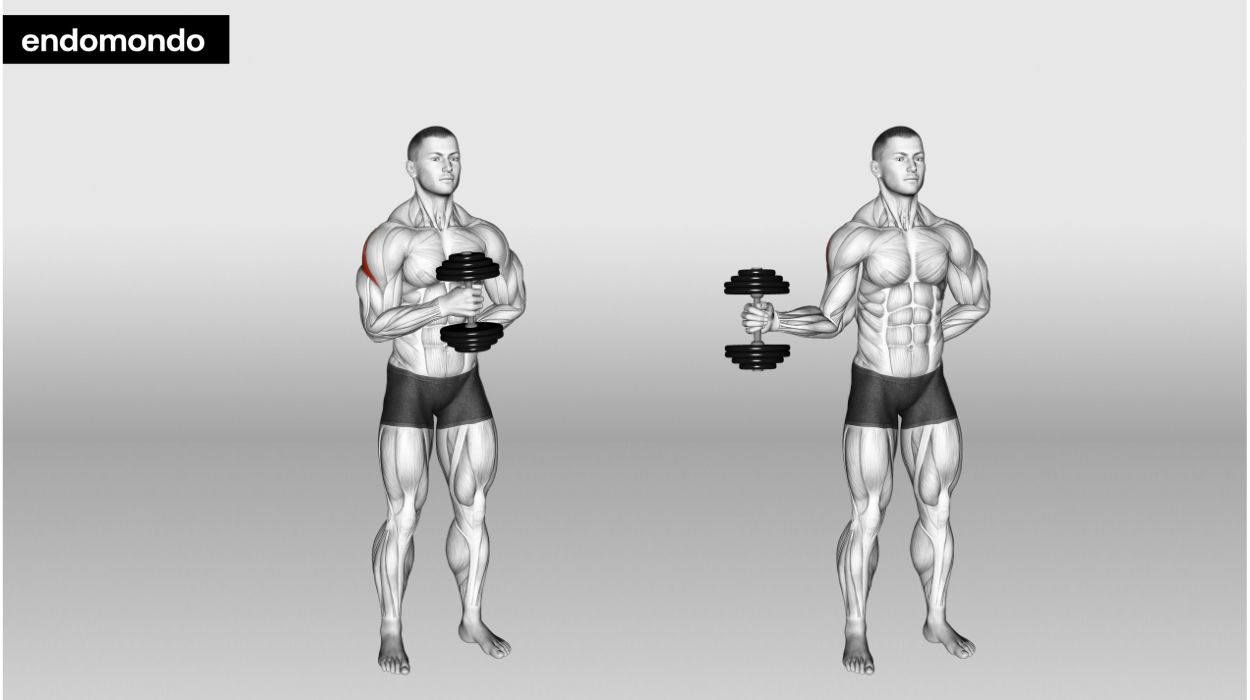
How to do:
- Stand with a dumbbell in one hand, elbow bent at 90 degrees,
- Keep the upper arm close to your side.
- Rotate the forearm outward, away from the body, maintaining the elbow’s position.
- Slowly return to the starting position, ensuring controlled movement.
- Perform the exercise for the recommended reps on both upper arms.
When performing the seated external rotation with a cable or band, sit straight with your chest out. Bend the knee to the side and hold the band.
Place your elbow on your knee, and, using the elbow as the focal point, rotate the forearm forward. Return to the top position and repeat the movement.
Tips:
To get the most out of the standing position variation:
- Keep the elbows close to your side.
- Keep your core engaged for stability and maintain a neutral spine.
- Control the movement to avoid using momentum.
Optimal Sets & Reps: 2-3 sets of 12-15 repetitions per arm.
Benefits Of Shoulder Exercises For Women
We touched on the importance of shoulder workouts for women earlier. Here, let’s dig deeper into the potential health benefits.
Shoulder Sculpting & Definition
The first role of shoulder exercises is sculpting and defining the shoulder region. Sculpted shoulders are particularly important for women who exercise for competition purposes, such as body-building competitions.
Posture Enhancement
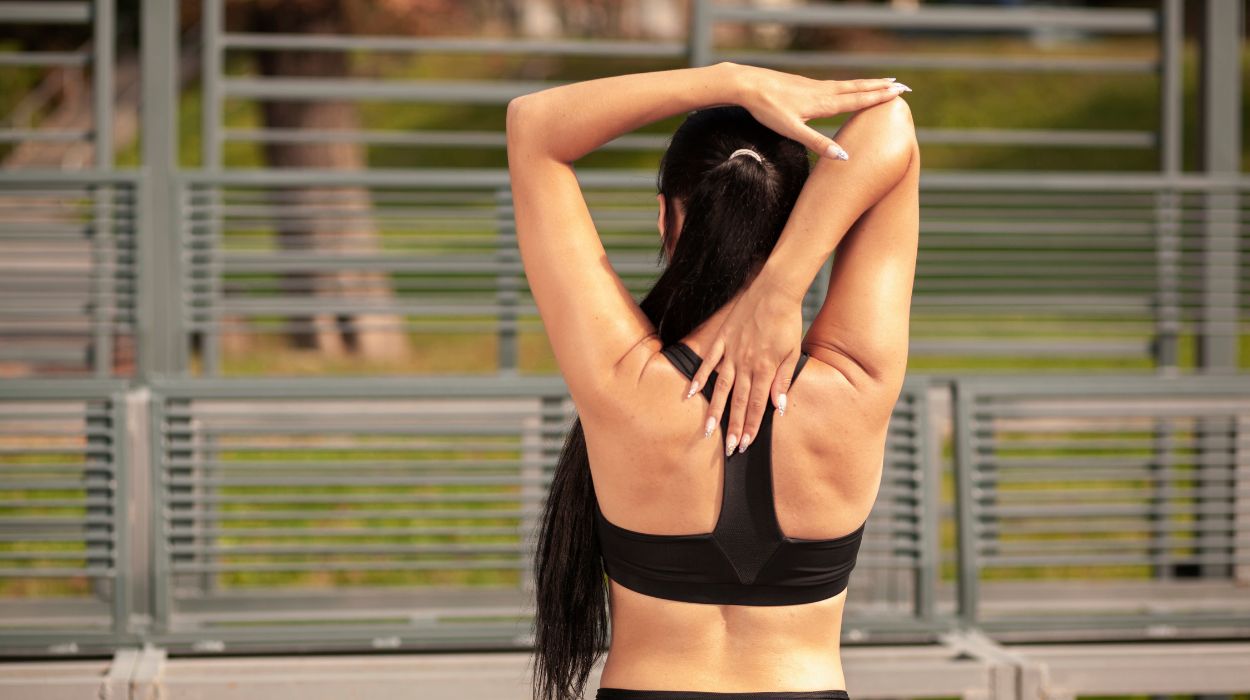
Working your shoulders also engages your back and chest muscles. These exercises can improve posture and strengthen the upper back muscles. They prevent rounded shoulders, fostering a confident and poised stance.
Upper Body Strength
Frontal, lateral, and rear delt exercises contribute to overall physical empowerment. This allows women to tackle daily activities and fitness challenges with increased vigor. Athletes like swimmers and ball players significantly grow shoulder muscles for better performance.
Injury Prevention
Exercise generally increases bone density[8] and reduces bone loss in people with or predisposed to osteoporosis. Shoulder stabilization exercises also aid in the prevention of shoulder injuries.
Improves Joint & Bone Health
Shoulder exercises support the development of strong shoulder muscles in several ways.
They may promote mechanical loading, enabling your bones and joints to adapt to heavier weights. Shoulder exercises in this regard may help treat hypermobility spectrum disorder.[9] This connective tissue disorder manifests as excessive joint flexibility, potential pain, injuries, and instability.
These exercises may also trigger the release of growth hormones. This hormone stimulates connective tissue formation.[10] Shoulder work may also boost blood supply to the shoulder bone, facilitating healthy bone formation and repair.[11]
Rehabilitation
Shoulder exercises are efficient components of shoulder injury rehabilitation in women. A recent comparison of neuromuscular exercises and at-home shoulder workouts highlights that the first had better rehabilitation results[12] in patients with traumatic anterior shoulder dislocations. Neuromuscular exercises include training the nervous system and muscles to improve coordination, movement patterns, and athletic performance.
Internal and external rotations with bands or light weights are simple neuromuscular exercises. They are movements that emphasize engaging the muscle.
Please prioritize medical advice when doing any shoulder exercise to rehabilitate an injury. Always see a doctor to set a routine and have a professional trainer guide you.
Injury Prevention Tips

Whether you opt for a guided at-home or gym arm and shoulder workout, adhere to the following to minimize injury:
- Always Warm-Up: Begin each session with dynamic warm-up exercises. These activate the shoulder joints and muscles you aim to target during the workout. A proper warm-up enhances flexibility and circulation to prime your body for the upcoming activity.
- Proper Form and Technique: Whether lifting weights or engaging in bodyweight movements, correct form reduces injuries, strains, and imbalances.
- Gradual Progression: Gradual progression gives your body time to adjust to both heavier loads and intensity. You reduce acute injuries or chronic overuse issues when you allow your bones and shoulder joints to strengthen over time.
- Listen to Your Body: If you experience any shoulder pain, especially sharp or persistent sensations, stop. You can switch to a lighter load or a simpler variation or stop exercising to mitigate injuring yourself.
- Rest and Recovery: Having enough rest and sufficient sleep in between sets and workouts promotes muscle repair.[13] It also prevents burnout and reduces the risk of overtraining injuries.
- Professional Guidance: Always seek guidance from certified trainers and healthcare professionals. Getting personalized advice ensures the shoulder, chest, and arms workout aligns with your fitness level and health conditions. Professionals can also guide you through a healthy rehabilitation workout schedule in case of injury.
Conclusion
Shoulder exercises for women optimize bone health, improve posture and upper body strength, and support injury rehabilitation. These exercises come in many variations that you can train at home or the gym. Some people fit a push-day workout routine, while others opt for a pull workout day.
Here, you have six of the best shoulder exercises with potential variations as needed. No matter your selection, ensure you get professional guidance. Consult a doctor if you have any bone or muscle concerns. And consult a certified personal trainer for guidance during the workouts.
One last thing: maintain a balanced diet for healthy gains.
Frequently Asked Questions
Yes, women should work out their shoulders for overall strength, bone health, and aesthetics.
Building shoulder strength varies. Consistent training can show results in a few weeks or months.
A shoulder workout for women should occur 2-3 times weekly. Ensure you allow enough time for recovery between sessions.
Muscular gains in the shoulder may contribute to bigger, more defined shoulders. However, if your goal isn’t gaining muscle mass, seek counsel from a certified trainer to get the best-toned shoulders.
The overhead barbell press is highly effective for women’s shoulder development.
The rep numbers will vary depending on your fitness goals and level. If you are starting, consider starting with 8-10 reps per set.
Women can integrate shoulder exercises into various fitness programs, including weight loss, muscle toning, strength training, bodybuilding, and functional fitness programs.
Resources
- Alswat, K.A. (2017). Gender Disparities in Osteoporosis. Journal of Clinical Medicine Research, [online] 9(5), pp.382–387. doi:https://doi.org/10.14740/jocmr2970w.
- Ji, M.-X. (2015). Primary osteoporosis in postmenopausal women. Chronic Diseases and Translational Medicine, [online] 1(1), pp.9–13. doi:https://doi.org/10.1016/j.cdtm.2015.02.006.
- Kroell, J. and Mike, J. (2017). Exploring the Standing Barbell Overhead Press. Strength and Conditioning Journal, 39(6), pp.70–75. doi:https://doi.org/10.1519/ssc.0000000000000324.
- Kim, T.-W., An, D.-I., Lee, H.-Y., Jeong, H.-Y., Kim, D.-H. and Sung, Y.-H. (2016). Effects of elastic band exercise on subjects with rounded shoulder posture and forward head posture. Journal of Physical Therapy Science, 28(6), pp.1733–1737. doi:https://doi.org/10.1589/jpts.28.1733.
- Anon, (n.d.). Electromyography of Dumbbell Fly Exercise Using Different Planes and Labile Surfaces. [online] Available at: https://www.researchgate.net/publication/321342593_Electromyography_of_Dumbbell_Fly_Exercise_Using_Different_Planes_and_Labile_Surfaces8%E2%80%93504.%20doi:https://doi.org/10.47626/1679-4435-2022-698..
- MATSUMURA, A., Hiroshige Tateuchi, Nakamura, M. and Noriaki Ichihashi (2023). Effect of 8-week Shoulder External Rotation Exercise with Low Intensity and Slow Movement on Infraspinatus. Physical therapy research, 26(2), pp.58–64. doi:https://doi.org/10.1298/ptr.e10227.
- de-Queiroz, J.H.M., de-Medeiros, M.B., de-Lima, R.N. and Cerdeira, D. de Q. (2022). Exercise for rotator cuff tendinopathy. Revista Brasileira de Medicina do Trabalho, [online] 20(03), pp.498–504. doi:https://doi.org/10.47626/1679-4435-2022-698.
- Zhang, S., Huang, X., Zhao, X., Li, B., Cai, Y., Liang, X. and Wan, Q. (2021). Effect of exercise on bone mineral density among patients with osteoporosis and osteopenia: a systematic review and network meta‐analysis. Journal of Clinical Nursing, 31(15-16). doi:https://doi.org/10.1111/jocn.16101.
- Liaghat, B., Skou, S.T., Jørgensen, U., Sondergaard, J., Søgaard, K. and Juul-Kristensen, B. (2020). Heavy shoulder strengthening exercise in people with hypermobility spectrum disorder (HSD) and long-lasting shoulder symptoms: a feasibility study. Pilot and Feasibility Studies, 6(1). doi:https://doi.org/10.1186/s40814-020-00632-y.
- Birzniece, V. (2019). Exercise and the growth hormone–insulin-like growth factor axis. Current Opinion in Endocrine and Metabolic Research, 9, pp.1–7. doi:https://doi.org/10.1016/j.coemr.2019.04.006.
- Wazzani, R., Pallu, S., Bourzac, C., Ahmaïdi, S., Portier, H. and Jaffré, C. (2021). Physical Activity and Bone Vascularization: A Way to Explore in Bone Repair Context? Life, [online] 11(8), p.783. doi:https://doi.org/10.3390/life11080783.
- Eshoj, H.R., Rasmussen, S., Frich, L.H., Hvass, I., Christensen, R., Boyle, E., Jensen, S.L., Søndergaard, J., Søgaard, K. and Juul-Kristensen, B. (2020). Neuromuscular Exercises Improve Shoulder Function More Than Standard Care Exercises in Patients With a Traumatic Anterior Shoulder Dislocation: A Randomized Controlled Trial. Orthopaedic Journal of Sports Medicine, 8(1), p.232596711989610. doi:https://doi.org/10.1177/2325967119896102.
- Chennaoui, M. (2021). How does sleep help recovery from exercise-induced muscle injuries? Journal of Science and Medicine in Sport, [online] 24(10). doi:https://doi.org/10.1016/j.jsams.2021.05.007.




